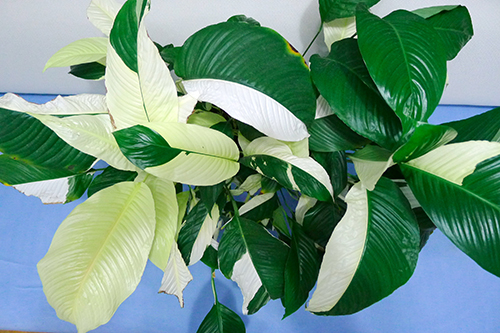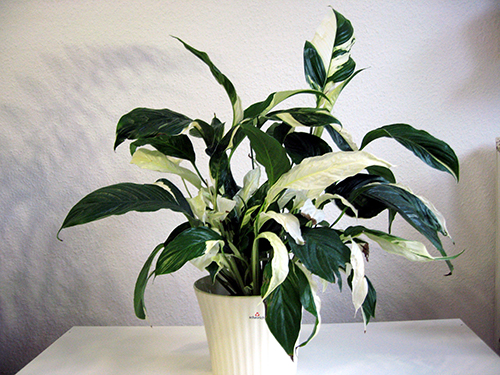Spathiphyllum Picasso variety
Spathiphyllum, belonging to the aroid family, became popular household plants only in the middle of the last century. These flowers are highly decorative, but initially it was difficult to grow them. The fact is that representatives of the genus in natural conditions grow only in the zone of humid tropical forests, they need constant high temperature and high humidity.
But through the efforts of breeders in the second half of the 20th century, new hybrids and varieties began to be created, more adapted to life in human dwellings. Florists sought to ensure that the emerging varieties were not only adapted to domestic conditions, but also showed variety in the color of the leaves, in the size of the plants. Among the newest, interesting and popular spathiphyllums is our current hero - the Picasso variety.

Description of the variety
To begin with, this flower is derived from one of the most common species - S. Wallis (Spathiphyllum wallisii).
Interesting! The species is named after the English writer, collector and botanist Henry Wallis. It was he who created the first truly scientific description of spathiphyllums, observing them in South America. S. Wallis turned out to be one of the most unpretentious, for which European breeders fell in love with him.
It is known that in natural nature, all types of spathiphyllums (and there are about fifty of them) have leaves of a rich green color. The Picasso variety, bred in Dutch nurseries, belongs to the so-called variegated specimens. Its leaf blade is not green, but variegated; it has light, almost white areas. Moreover, they sometimes take up most of the sheet! The bracts of Picasso also look variegated, greenish-white.
In the world of spathiphyllums, variegation is a rarity. Perhaps only the Domino variety can boast of this property, but its white sectors are still smaller than our hero's. It is variegation that is the main and most valuable property that distinguishes it from all its fellows.
As for the size and shape of the leaves, they are standard for Spathiphyllum wallisii. The height of specimens rarely exceeds 40 cm, usually slightly less. The tips of the leaves are pointed, the same can be said about the bracts. To some growers, it resembles a large, elongated spoon for sauce, and in this sense, the bedspread was not lucky, because the colorful leaves of the plant are compared to the immortal creations of Picasso himself!
What conditions does spathiphyllum require for home keeping?
Lighting
For this variety to be able to demonstrate all its decorative charm, it needs abundant, bright, but diffused lighting. Moreover, it is desirable that the condition is fulfilled throughout the year. If the owner manages to provide it, otherwise there should be no problem.

It is important to understand that in spring and summer, the light should be bright, but not harsh. From direct sunlight, the leaf plate becomes pale, the transitions between green and light segments lose their clarity. It seems as if the sheet is covered with a layer of dust.
If there is not enough light, the variegation gradually disappears, the leaves become almost green. Thus, Picasso will lose his main feature. And if in the spring-summer period the issue is still being resolved, then in winter the flower will have to be additionally illuminated with artificial lighting.
Summing up this section, we can conclude: the plants of the variety should be kept in places with a southern or southwestern exposure, while shading them in the summer with a thin screen (for example, gauze).
Comfortable temperatures and humidity
At the beginning of the article, it was not for nothing that we mentioned that spathiphyllums are from the tropics. They love moist air and warmth. For these flowers, the annual temperature fluctuation is not necessary, ideally, both in winter and in summer, it should be from 18 to 25 °. Naturally, in the winter months, the bias is downward, but even 16 ° can become critical.
But too much heat will not do the plant good.If it is observed, it is imperative to increase the humidity of the air. In general, the more often you can moisturize it around your pet, the better. Use whatever product is available: electric humidifier, wide pan of wet claydite, continuous spraying
Features of watering and soil
The roots of these flowers should always be in moist soil, but at the same time, stagnation of water in the pot should not be allowed. Usually watering is done when the top layer of the substrate has dried out, but the bulk of the earth is still wet. In winter, when temperatures are low, watering is reduced, to about once every 3-4 days.
The water should be settled, soft, not colder than the air temperature. If you use tap water, it should be slightly acidified from time to time.

Spathiphyllum are undemanding to soil fertility. The main thing is that the substrate in the pot is loose, permeable, well saturated with air. In the lower part of the pot, there must be a high-quality drainage layer, the holes in the bottom should be large, not clogged with soil.
You can buy ready-made soil for aroids, but if you have even a little experience, risk making the mixture yourself. Focus on the following composition:
- light sheet earth - 2 parts;
- humus - 0.5 parts;
- peat, preferably horse peat - 1 part;
- coarse river sand - 1 part;
- finely chopped pine bark —0.5 parts.
It is useful to add crushed charcoal to the resulting mixture (a tablespoon per liter of volume), as well as a little complex mineral fertilizers.
Transplant and reproduction of Picasso
Usually, the transplant is carried out in early spring, while the pot is taken a little more than the previous one. If your specimen is already old, large, you can only change the topsoil for it, and do a full transplant after one, or even two springs.
It is useful to combine spring planting work with reproduction. Spathiphyllums produce root shoots that can be carefully separated from the parent plant and planted in separate pots. This breeding method is easy, affordable and effective.
With good care, this variety will adorn your flower collection, a living picture that can give emotions no less than the creations of the legendary Picasso!









I like Spathiphyllums, BUT I like “Classic” Spathiphyllums - green foliage and bright white-greenish bracts. I understand that variegated forms are a rare rarity, that such plants practically do not occur in natural nature, and breeders have done a lot of work in this direction, but variegated spathiphyllum seems lurid to me - it is very difficult to understand where the leaves are, where the flowers are ... for my eye such a plant ugly and inharmonious. In all other respects, I can say that spathiphyllum is a wonderful plant - it is not at all difficult to care for (the ideal place is on a light windowsill in the kitchen, there is always high humidity), I water it rarely, but abundantly (I put it in the sink and gently water it with hot water from under tap), transplant or transplant only when roots appear in the drainage holes.